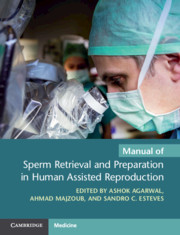Book contents
- Manual of Sperm Retrieval and Preparation in Human Assisted Reproduction
- Cambridge Laboratory Manuals in Assisted Reproductive Technology
- Manual of Sperm Retrieval and Preparation in Human Assisted Reproduction
- Copyright page
- Dedication
- Contents
- Contributors
- Editor Biographies
- Preface
- Part I Introduction
- Part II Sperm Retrieval
- Part III Laboratory Handling of Retrieved Sperm
- Chapter 11 Critical Factors for Optimizing Sperm Handling and ICSI Outcomes
- Chapter 12 Sperm Cryopreservation
- Chapter 13 Future Directives in Sperm Handling for ART
- Index
- References
Chapter 12 - Sperm Cryopreservation
from Part III - Laboratory Handling of Retrieved Sperm
Published online by Cambridge University Press: 09 April 2021
- Manual of Sperm Retrieval and Preparation in Human Assisted Reproduction
- Cambridge Laboratory Manuals in Assisted Reproductive Technology
- Manual of Sperm Retrieval and Preparation in Human Assisted Reproduction
- Copyright page
- Dedication
- Contents
- Contributors
- Editor Biographies
- Preface
- Part I Introduction
- Part II Sperm Retrieval
- Part III Laboratory Handling of Retrieved Sperm
- Chapter 11 Critical Factors for Optimizing Sperm Handling and ICSI Outcomes
- Chapter 12 Sperm Cryopreservation
- Chapter 13 Future Directives in Sperm Handling for ART
- Index
- References
Summary
Human sperm cryopreservation is a highly desirable technique for preserving fertility potential and future use in couples desiring to have a biological child. Slow cryopreservation of sperm has been the mainstay technique. The drawback of this technique is the inability to freeze extremely small numbers of sperm as in the case of surgical retrieval of testicular sperm. These sperm are extremely few in number and it is difficult to retrieve motile, viable sperm post-thaw. In the past decade, sperm vitrification has been introduced along with both biological and non-biological carriers to freeze extremely low numbers of sperm. Vitrification also allows the ability to freeze single spermatozoa. These techniques are in many ways more efficient and better than the older techniques. This chapter aims to provide a detailed introduction to various approaches used for preserving spermatozoa. It also discusses indications of sperm cryopreservation based on semen quality and summarizes the advantages and shortcomings of these techniques.
Keywords
- Type
- Chapter
- Information
- Publisher: Cambridge University PressPrint publication year: 2021
References
- 2
- Cited by

